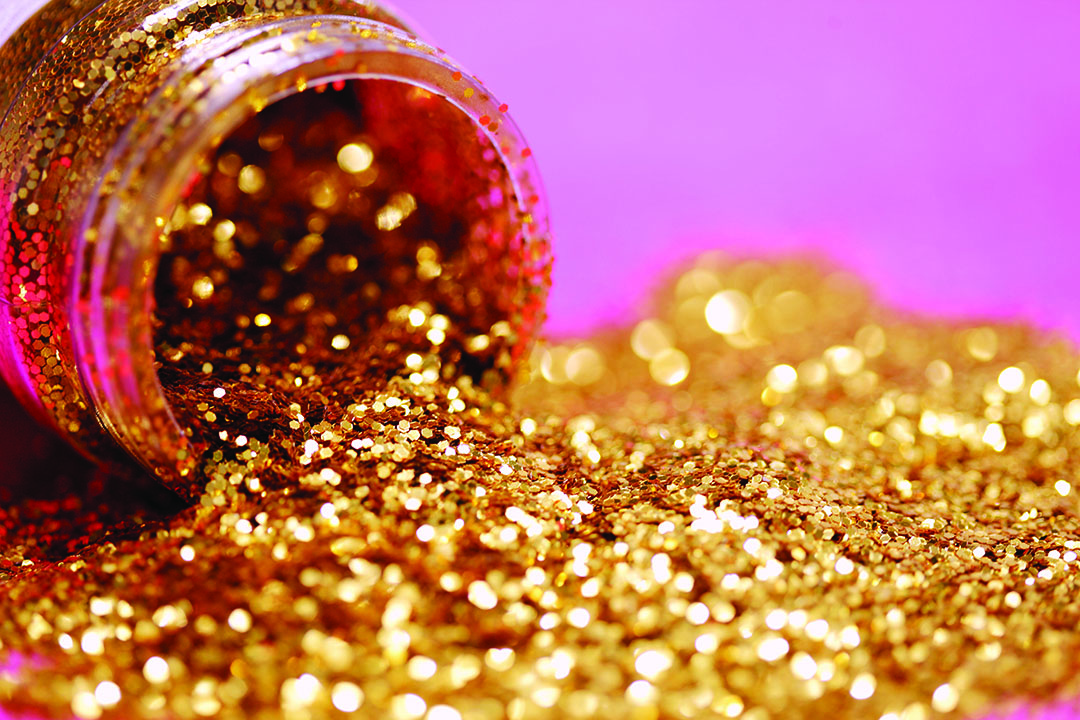From eyeshadows to trendy lipsticks, many cosmetic products use glitter to give you a sparkle and create glamorous looks. Most glitter, however, is composed of tiny pieces of metallised plastic films, classed as microplastics, which pose threats of pollution to terrestrial and aquatic environments. This plastic debris is easily ingested by wildlife, causing increased risks of congestion in their organs and respiratory systems. Moreover, urban microplastic contaminations can be propagated in the atmosphere by wind.
Unless we want to get rid of glitter completely — which doesn’t seem likely or even possible — the wide use of glitter in everyday products calls for the development of eco-friendly alternatives.
The science of sparkles
The base material of human-made glitter actually has the same chemical composition as plastic water bottles. Thin sheets of petroleum-based polyethylene terephthalate (PET) are cut into pieces that can be as tiny as 50 by 75 thousandths of a millimeter — smaller than the thickness of paper — to make clear glitter. In order to fabricate glitter that has a metallic glow, PET sheets must be metallised, a process that involves aluminum being deposited on both sides of the plastic film.
The colour-changing effect of glitter arises from the refractive indexes of multi-layered polymers rather than any intrinsic property. Another issue with petroleum-based glitter is that it is made out of fossil fuels, which are a finite resource. However, it is still generally used as a disposable product, such as when it is mixed in animal feed to track animals via trails of sparkly feces. For the sake of environmental protection, demands for easily biodegradable glitter are growing ever more significant.
Plant-based alternative to microplastics
The scientific community has long been interested in the idea of using cellulose nanocrystals (CNC) derived from plant polymers to produce coloured films, which could act as a sustainable base for light-refracting pigments. In 2021, a team of UK researchers from the University of Cambridge optimized existing methodologies of producing CNC films. The experiment shows promising prospects for the large-scale commercialization of eco-friendly glitter.
A large sheet of light-refracting CNC film was produced from aqueous CNC via a technique known as roll-to-roll (R2R) coating, which is much like the process where aluminum is deposited onto PET sheets. R2R coating involves applying fluid CNC onto an unwinding roll of a flexible foundation that is subsequently rewound onto an adjacent roll. The process is similar to a 35 millimetre film tape rolling out of its canister, capturing an image, and winding around the roller on the other side.
There are several criteria that CNC films must fulfill to be used for the industrial manufacturing of glitter. First, the liquid CNC crystal must already have a special structure on the thin sheet films to produce colouration. The CNC fluid has to have sufficient viscosity to evenly coat the rolled foundation without forming droplets. Manufacturers must avoid anything that could cause shrinkage in the applied CNC fluid coating at all costs in the process of drying it.
CNC self-assembly is a critical step that happens after R2R coating, during the brief time window before the applied fluid coating completely evaporates. Self-assembly is a scientific term describing the spontaneous formation of an organized structure from local interactions between its components. After this, the CNC sheets are ready to be further processed into sparkly microparticles.
Industrial relevance of the R2R technique
CNC sheets undergo heat, grinding, then sorting by size to produce tiny particles that can be used as glitter. The grinding process does not fracture CNC films randomly but produces smooth particles with sharp edges. The heat treatment also stabilizes the microparticles so they do not dissolve or break down any further.
The finished product is flake-like particles that refract different colours depending on the angle of light source, giving the glitter its characteristic metallic glow. CNC glitter has a shelf life of at least a year where these microparticles can retain their optical response without fading or disintegrating, even if the microparticles are immersed in water. Furthermore, the researchers found that the visual quality of the eco-friendly glitter is comparable to regular petroleum-based glitter.
So, you do not have to fear losing your signature makeup look. As long as you make the eco-friendly choice, glamour is guaranteed!


